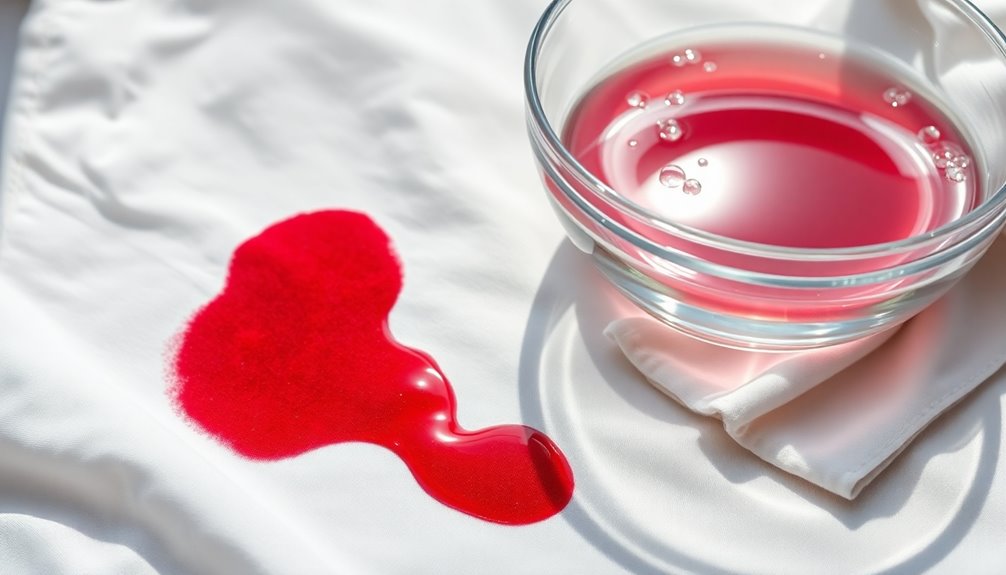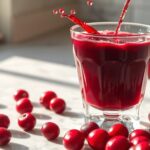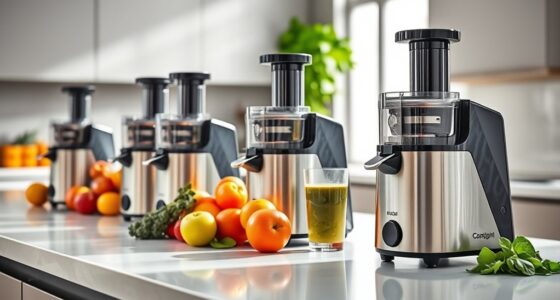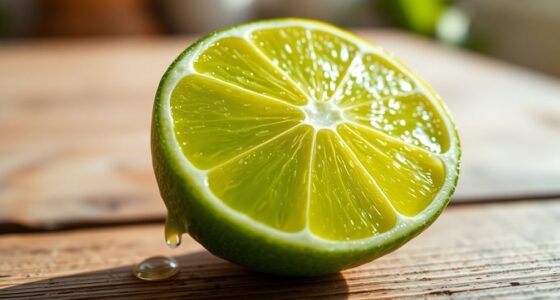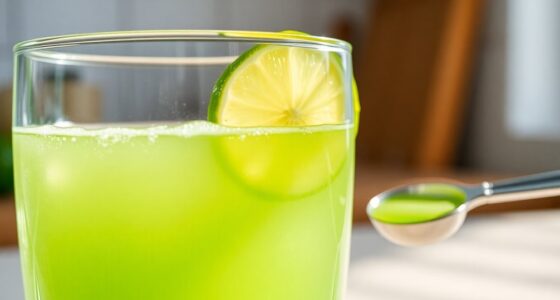To get cranberry juice stains out of clothes, act fast! Blot the stain gently with a clean cloth, then rinse with cold water. Apply a quality enzyme-based stain remover to the stained area and let it sit for 15 minutes. Wash the garment in the hottest safe water, but avoid the dryer until the stain is gone. If the stain persists, soak the fabric in oxygen bleach and rinse well. More tips and techniques await!
Key Takeaways
- Act quickly by blotting the stain with a clean white cloth and rinsing under cold water to remove excess juice.
- Use hot water for rinsing colorfast or white fabrics to help lift the stain before treatment.
- Apply a quality enzyme-based stain remover directly to the stained area and let it sit for at least 15 minutes.
- Wash the garment in the hottest water safe for the fabric, checking the care label for guidance before drying.
- For stubborn stains, soak the fabric in oxygen-based bleach and water, then rinse thoroughly and launder again.
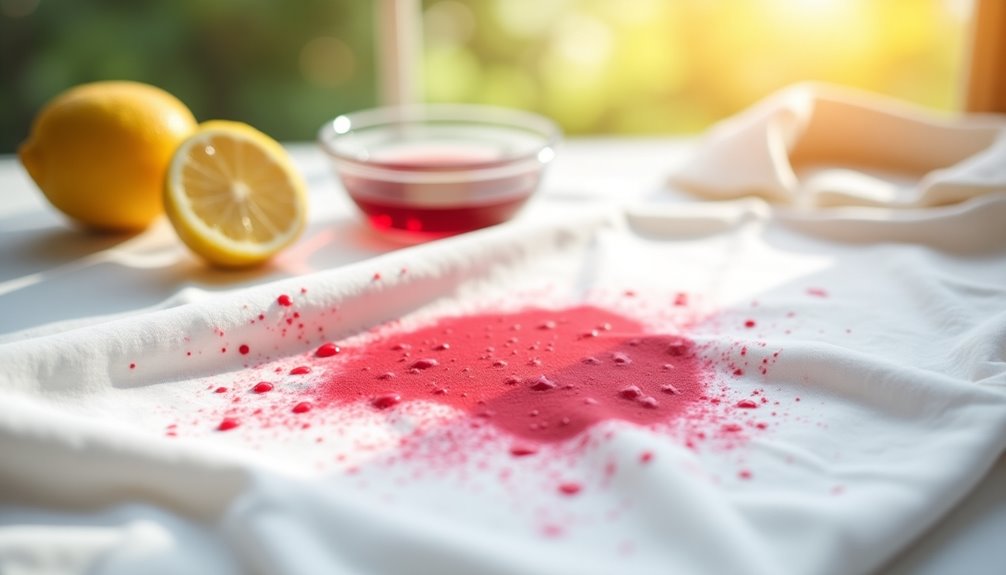
Cranberry juice stains can be a real headache, but tackling them doesn't have to be. When you find yourself dealing with an unsightly stain from that delicious drink, you can take quick steps to remove it effectively. The key is to act fast and follow the right procedures. With a few simple techniques, you can restore your fabric and keep your clothes looking fresh.
First things first, you'll want to address the stain as soon as possible. Grab a clean white cloth and gently blot the area where the cranberry juice has spilled. It's essential that you avoid rubbing the fabric, as this can spread the stain even further. Blotting helps absorb the excess liquid, making it easier to lift the stain.
Once you've done that, it's time to rinse the stained area under cold running water. This step is crucial because rinsing helps to lift the stain before you apply any treatments. If the fabric is colorfast or white cotton, you can use hot water for this step.
After rinsing, apply a quality enzyme-based stain remover or a heavy-duty laundry detergent directly to the stain. Make sure you cover the entire stained area and allow it to sit for at least 15 minutes. The enzymes in the stain remover will work to break down the cranberry juice, making it easier to wash away.
Once the time is up, you can wash the garment in the hottest water that's safe for the fabric, as indicated on the care label. Be cautious here; it's essential not to put the garment in the dryer until you're certain that the stain is completely gone. Heat can set stubborn stains, making them nearly impossible to remove.
If you're dealing with older or particularly stubborn stains, you might need to take a more aggressive approach. Consider soaking the fabric in a solution of oxygen-based bleach and water. Make sure to follow the manufacturer's instructions for best results. This method can be especially effective for lifting those tough cranberry juice stains that just won't budge.
After soaking, rinse the fabric thoroughly under cold running water to wash away any remaining bleach solution. Then, launder the item again as you normally would. With these steps, you've significantly increased your chances of removing those pesky stains from your clothing.
Frequently Asked Questions
What Gets Cranberry Juice Out of Clothes?
To tackle cranberry juice stains effectively, you'll want to act fast.
Blot the stain gently with a clean cloth to soak up excess juice. Rinse it under cold water for non-colorfast fabrics or hot water for colorfast ones.
Next, apply an enzyme-based stain remover or heavy-duty detergent directly on the stain, letting it sit for about 15 minutes before washing.
Always check the area afterward; repeat if necessary before drying.
How to Get Cranberry Sauce Out of a White Shirt?
To get cranberry sauce out of your white shirt, start by gently blotting the stain with a clean cloth to absorb excess liquid.
Rinse the area under cold running water, flushing from the back to push the stain out.
Apply a liquid enzyme stain remover or heavy-duty detergent directly to the stain and let it sit for at least 15 minutes.
Finally, wash the shirt in the hottest water safe for the fabric.
How Do You Get Berry Juice Stains Out of Clothes?
To tackle berry juice stains on clothes, start by blotting the area with a clean cloth to soak up excess liquid.
Rinse the fabric under cold water, then apply an enzyme-based stain remover or heavy-duty detergent, letting it sit for about 15 minutes.
Wash according to the care label, and if the stain persists, soak it in oxygen-based bleach and cool water.
Always air dry first to avoid setting any remaining stains.
Does Oxiclean Get Out Cranberry Juice?
Yes, OxiClean can effectively get out cranberry juice stains. Its oxygen-based bleaching agents break down tough stains, making it a great choice for your laundry.
You'll want to pre-soak the stained item in a solution of OxiClean and cold water for at least 30 minutes before washing. For stubborn stains, applying OxiClean directly to the stain can boost its effectiveness.
Just remember to follow the manufacturer's instructions to protect your fabric!
Conclusion
In conclusion, tackling cranberry juice stains doesn't have to be a Herculean task. By acting swiftly and using common household items, you can restore your garments to their former glory. Remember, even in the age of smartphones and instant messaging, a little patience and persistence can yield remarkable results. So, don't fret over those pesky stains; just follow the steps, and you'll be back to looking dapper in no time.
Cindy thoroughly researches juicing trends, techniques, and recipes to provide readers with practical advice and inspiration. Her writing style is accessible, engaging, and designed to make complex concepts easy to understand. Cindy’s dedication to promoting the advantages of juicing shines through her work, empowering readers to make positive changes in their lives through the simple act of juicing.

